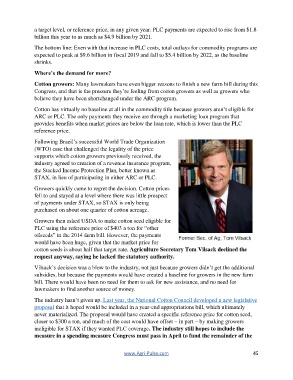Page 47 - Farm Bill Series_The 7 Things You Should Know
P. 47
a target level, or reference price, in any given year. PLC payments are expected to rise from $1.8
billion this year to as much as $4.9 billion by 2021.
The bottom line: Even with that increase in PLC costs, total outlays for commodity programs are
expected to peak at $9.6 billion in fiscal 2019 and fall to $5.4 billion by 2022, as the baseline
shrinks.
Where’s the demand for more?
Cotton growers: Many lawmakers have even bigger reasons to finish a new farm bill during this
Congress, and that is the pressure they’re feeling from cotton growers as well as growers who
believe they have been shortchanged under the ARC program.
Cotton has virtually no baseline at all in the commodity title because growers aren’t eligible for
ARC or PLC. The only payments they receive are through a marketing loan program that
provides benefits when market prices are below the loan rate, which is lower than the PLC
reference price.
Following Brazil’s successful World Trade Organization
(WTO) case that challenged the legality of the price
supports which cotton growers previously received, the
industry agreed to creation of a revenue insurance program,
the Stacked Income Protection Plan, better known as
STAX, in lieu of participating in either ARC or PLC.
Growers quickly came to regret the decision. Cotton prices
fell to and stayed at a level where there was little prospect
of payments under STAX, so STAX is only being
purchased on about one quarter of cotton acreage.
Growers then asked USDA to make cotton seed eligible for
PLC using the reference price of $403 a ton for “other
oilseeds” in the 2014 farm bill. However, the payments
would have been huge, given that the market price for
cotton seeds is about half that target rate. Agriculture Secretary Tom Vilsack declined the
request anyway, saying he lacked the statutory authority.
Vilsack’s decision was a blow to the industry, not just because growers didn’t get the additional
subsidies, but because the payments would have created a baseline for growers in the new farm
bill. There would have been no need for them to ask for new assistance, and no need for
lawmakers to find another source of money.
The industry hasn’t given up. Last year, the National Cotton Council developed a new legislative
proposal that it hoped would be included in a year-end appropriations bill, which ultimately
never materialized. The proposal would have created a specific reference price for cotton seed,
closer to $300 a ton, and much of the cost would have offset – in part – by making growers
ineligible for STAX if they wanted PLC coverage. The industry still hopes to include the
measure in a spending measure Congress must pass in April to fund the remainder of the
www.Agri-Pulse.com 45

